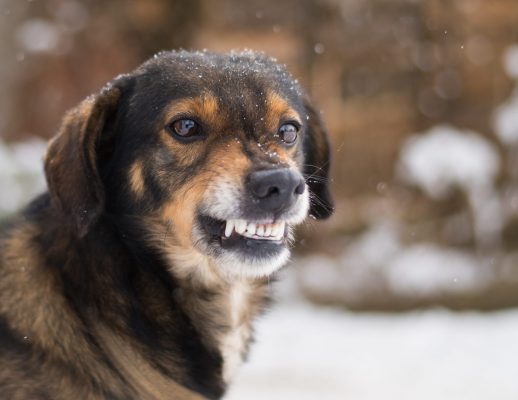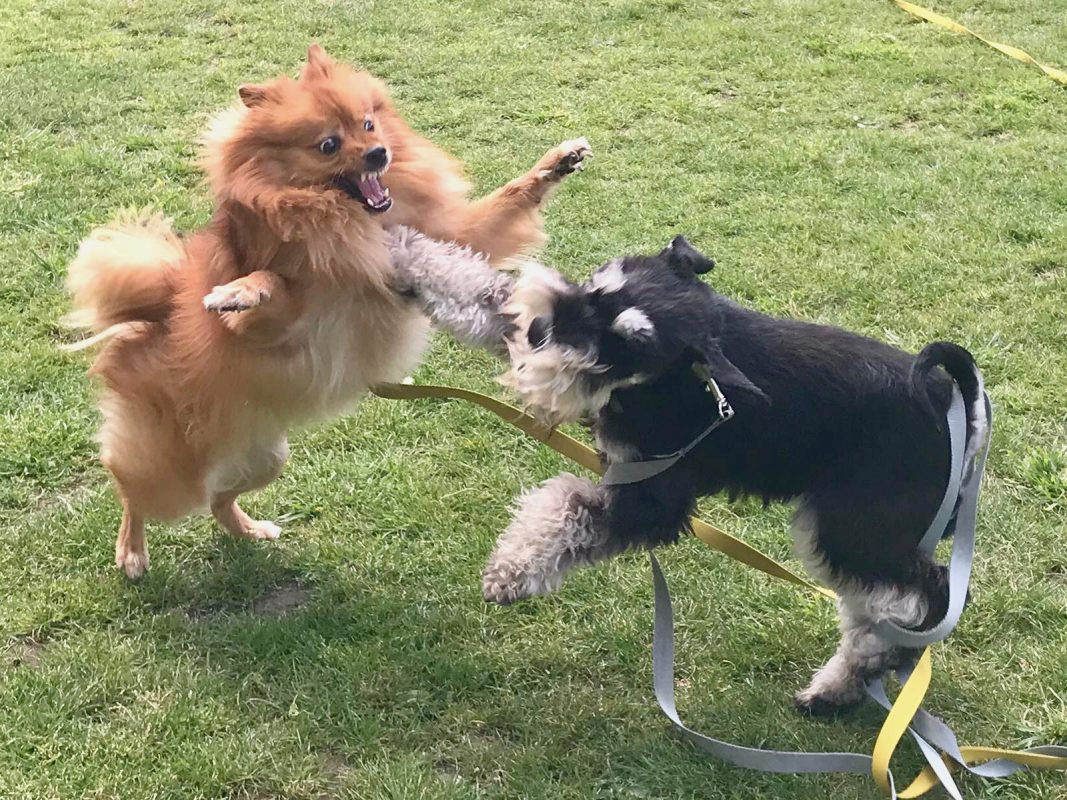News
How to Tell if Your Dog is Playing or Fighting?
Do you sometimes find it difficult to tell if your dog is playing or fighting? Have you ever wanted to step in only to realise your dog was just play-fighting? It takes time for most new dog owners to learn their dog’s personality. From little quirks, to almost obsessive compulsive behaviours, every dog is different. Dogs use signals to communicate, this can be audible, such as a specific type of bark for “Give me treats!” or with body language, such as curling their lip when their access to food or cherished resources such as their owner or a toy, is threatened.
But when it comes to dog playing or fighting, there’s no one single reason why a dog will suddenly bare its teeth and go on the attack – sometimes it’s all in good fun and play, and at others it’s a serious sign of escalating aggressiveness in the dog.
In a 2020 UK study, it was found that roughly 15% of adult UK dog owners had seen their pet attacked by another dog during the 12 month period.
Generally, well socialised dogs will avoid physical or aggressive confrontation, and use body language to communicate (both with people and other animals) their emotional and mental state.
But how do you tell if your dog is playing or fighting? And what do these behaviours actually mean? How can you identify the signs of aggression in dogs?
We’re going to have a look at the importance of play-fighting, then at aggression – what might cause it, potential warning signs, and situations that might trigger it, as well a few different ways you can start to identify the difference between play and problem.dogs
Play-fighting is Actually an Essential Part of Your Dog’s Development
Play-fighting starts in puppyhood and is actually an important part of the learning and socialising process for a dog. You may have noticed that older, and often much bigger dogs, will put up with a LOT of spiky toothed abuse from puppies – this is because the pup is exploring their coordination and strength control, and learning to develop their hunting instincts.
It can be distressing to hear a dog yelp when the puppy bites too hard, but this audible cue is part of the process, it indicates to the puppy that they’ve bitten too hard or are getting too out of hand – and when it’s combined with playtime stopping or a punitive action (gentle nip) from the older dog or mother, it educates them that they need to not repeat the action, otherwise play won’t recommence.
Socialisation is an extremely important part of a dog’s formative growth period, and in their daily lives as they get older.
In a 2020 study, it was found that, “Fearfulness is one of the most frequent canine behavioural problems as the prevalence of fearfulness ranges from 26.2% even to 44%, and around 10-19% of dogs show fear of strangers or dogs,” and it was revealed that, “fearful dogs were less socialised during puppyhood, small in body size, females and neutered, and participated less frequently in training and other activities.”
Of course, play fighting isn’t just a ‘puppy thing’, as dogs get older, they continue to engage with the behaviour, rough housing with each other and with their human family. The behaviour of the dog during play time is often confident, relaxed, and frankly – wiggly, as they vocalise their happiness with barks, wuffs, and snorts.
It’s important to monitor playtime, both with canine and human companions. If the body language of your dog becomes tense, over-excited, or they start to back away into a defensive position, it’s time to stop and calm the situation down before it can escalate into aggression or a fight.
What Are Some of the Most Noticeable Signs of Aggression in Dogs?
Although by no means a comprehensive list, some of the most prominent warning signs that indicate a change from playfulness to aggression include:
🐾 Stiff Posture – If your dog goes from being relaxed to tense, this is an indication that they’ve identified a threat, either to their pack or to themselves, and they’re evaluating their situation to decide on what move they should make.
🐾 Lip Curling (Snarling) – Watch your dog’s muzzle, if they’re curling their lips and baring their teeth, this can be an indicator that they’re not happy, and are warning the subject of their focus to back off.

🐾 Growling – This is a more difficult indicator, as growls can happen either in dog playing or fighting. However, if you’re familiar with the types of noise your dog makes. you’ll notice when the tone of the growl changes and becomes more ‘serious’ – especially if it goes deep and low.
🐾 Challenging Stare – If your dog is getting distressed, they may try to ‘stare down’ their opponent, it’s an indicator of stress, but can have the consequence of acting as a challenge to another dog, which may provoke them to attack first.
🐾 Flattened Ears (Ears Going Back) – When your dogs ears go from playful and forward, to pinned back against their head, this can be a visual identifier that they’ve gone into a state of alertness and potential stress.
🐾 Freezing Up – If your dog becomes tense, they may freeze up and look to be in a rigid state. It’s important to realise, that although they’re not moving in that instance, canine reaction times can be extremely fast, and they can move from frozen still to action very quickly.
🐾 Raising their Hackles – The hair on the back of your dog’s neck may literally stand up, indicating that they’ve identified a threat and are preparing to defend themselves or their pack.
🐾 Lunging and Snapping – This is where your dog seems to dance round, snapping – they don’t generally make contact (although they might), but the action serves as a clear warning that they are now in a defensive mindset, and are willing to attack those who come too close to them or the particular object of their defence.
When discussing Dog Behaviour problems, Debra Horwitz and Gary Landsberg, experts at the VCA Animal Hospitals in the United States, say that, “Aggression between unfamiliar dogs can be due to fear, poor communication, defensive, possessive behaviour over resources (including perhaps family members or other pets) or territorial behaviour over territory or owner.”
Of course, aggression in dogs aren’t just limited to reactions between animals – dogs may perceive people as a threat, and it’s important to monitor their reactions, not just with children (who may inadvertently stress a dog with uninhibited or unintentionally painful behaviour such as fur pulling), but adults as well.
How you as the dog’s owner react, and determine if their dog us playing or fighting is a crucial factor in diffusing a potential situation. Dogs are extremely intuitive – they are pack animals – and hierarchy is important to them. They may challenge each other (and you) for position at the top from time to time, but it’s important to realise that they will take their cues from the one they perceive as the Alpha – and if you as their Alpha are showing signs of fear, stress, panic, or anger, they’re going to recognise these emotions, and react accordingly.
“If the owners cannot successfully control the dog and resolve the situation without heightening the dog’s anxiety or increasing its fear, the problem will escalate with each subsequent exposure.” – Debra Horwitz and Gary Landsberg, VCA. The owner’s ability to assess the situation correctly – if the dog is playing or fighting – is crucial in developing assertiveness and confidence in their dog. A jumpy, nervous owner who perceives any interaction as a threat will almost always end up with a dog that becomes aggressive, and is anxious in many situations.
What Are Some of the Situations that Can Cause Dog Fighting or Aggression in Dogs?
Knowing how to deescalate a situation is important but knowing what might cause it and avoiding it in the first place is crucial – a problem avoided is infinitely preferable to having to resolve one after all.
Aggression isn’t always caused by outside factors and can sometimes be an indication that your dog has an underlying health condition which could include suffering from chronic pain, certain brain conditions, low calcium levels, fights in lactating females, hypothyroidism, just to name a few. If your dog has been experiencing unpredictable or unusual behaviours, it’s certainly recommended that you seek veterinary advice to check their health.
But for aggression caused by outside factors, this again, isn’t an exhaustive list, and it’s important that you keep your own dog in mind – their particular breed, age, personal quirks, likes, and dislikes are all factors which will contribute to how they perceive and cope with a situation.
But some common stressors that can instigate an aggressive reaction include:
🐾 Territorial Invasion – Dogs are territorial creatures, and if they see another animal or person as invading their space, they will feel threatened and react accordingly.
🐾 Food – We have to remember that dogs were originally wild animals, and preservation of a food source is an instinctual response. If your dog feels they’re going to lose their food, they may very well fight to keep it.
🐾 Possessions – Bedding, favourite toys, a newly discovered stick, these are all potential triggers that might set a dog off if they think that another dog is going to take them away from them. They may also get defensive if a person tries to take their possessions away, and this should be carefully monitored and controlled with a consistent training approach – NEVER with aggression or violence.
What Can You Do to Minimise Dog Fighting and Aggression in Dogs?
Paying attention to your dog, their normal behaviours, quirks, and personality traits is a good start – it will give you a baseline understanding to determine if they’re behaving strangely, or acting differently.
Training and positivity, calm environments, and assessing each situation as you come across it will also help. For example, if you’ve got a family member coming to visit with their pup, make sure you’ve put the food bowls, toys and bedding up out of the way – as we mentioned before, preventing a situation is far preferable to running damage control after one.
Or if you know that your dog finds it difficult to sit still and quiet for long periods of time, and gets stressed by having to do so, providing them with a long-lasting chew or toy can give them something to occupy their mind.
Exercise and careful socialisation is an important aspect of your dog’s life – if they’re getting plenty of fresh air and exercise, they’re going to be less stressed; and if they know how to interact and engage with other dogs, it will help to prevent stress or fear based reactions and incidents. There are some fantastic training tools available to help you and your dog, including collars, leads, and harnesses that give you more control on a walk.
Taking the time to understand your dog, and manage their encounters and experiences is something that requires a personal approach, as although we’ve identified some triggers and warning signs, you know your dog best, and how they’ll behave in different situations, because at the end of the day, our dogs are part of our family – and giving them the tools and training to live their best life is what we do.


